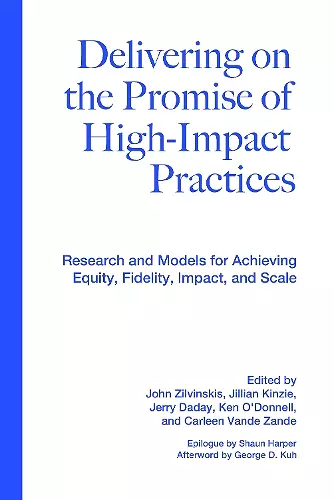Delivering on the Promise of High-Impact Practices
Research and Models for Achieving Equity, Fidelity, Impact, and Scale
John Zilvinskis editor Jillian Kinzie editor Jerry Daday editor Ken O'Donnell editor Carleen Vande Zande editor
Format:Hardback
Publisher:Taylor & Francis Inc
Published:13th Jul '22
Currently unavailable, and unfortunately no date known when it will be back
This hardback is available in another edition too:
- Paperback£36.99(9781642673616)

Research shows that enriching learning experiences such as learning communities, service-learning, undergraduate research, internships, and senior culminating experiences – collectively known as High-Impact Practices (HIPs) – are positively associated with student engagement; deep, and integrated learning; and personal and educational gains for all students – particularly for historically underserved students, including first-generation students and racially minoritized populations. While HIPs’ potential benefits for student learning, retention, and graduation are recognized and are being increasingly integrated across higher education programs, much of that potential remains unrealized; and their implementation frequently uneven. Colleges are eager to use the HIP nomenclature for recruitment, promoting equity for traditionally underserved student populations, and preparing lifelong learners and successful professionals. However, HIPs defy easy categorization or standardized implementation. They rely on fidelity, quality, and consistency – being “done well” – to achieve their learning outcomes; and, above all, require attention to access and equity if they are to fulfill their promise of benefitting all student populations equally.The goal of Delivering on the Promise of High-Impact Practices is to provide examples from around the country of the ways educators are advancing equity, promoting fidelity, achieving scale, and strengthening assessment of their own local high-impact practices. Its chapters bring together the best current scholarship, methodologies, and evidence-based practices within the HIPs field, illustrating new approaches to faculty professional development, culture and coalition building, research and assessment, and continuous improvement that help institutions understand and extend practices with a demonstrated high impact. For proponents and practitioners this book offers perspectives, data and critiques to interrogate and improve practice. For administrators it provides an understanding of what’s needed to deliver the necessary support.
“Privileging students who would benefit most from HIPs is the final shift I am calling for here. A middle-class student who routinely traveled internationally with family members for several years prior to enrolling in college would probably benefit less from an overseas study abroad experience than would a lower-income classmate who has never been on an airplane. Ideally, every student would have full access to HIPs, but few campuses have the capacity and resources to offer these experiences to everyone. Hence, I insist on placing students who are not typically engaged in HIPs at the front of the line and making every strategic effort to connect them with these experiences. That would be equity.
This new book is another incredibly useful contribution to the student engagement and assessment literature. Inequity is our past and present. We must embrace the shifts I have presented here to deliver on the promise of a more equitable future."
From the epilogue by Shaun R. Harper, University of Southern California
"Whether one is an enthusiastic advocate of High Impact Practices or in the “I’d like more evidence, please” camp, Delivering on the Promise of High-Impact Practices is the book to read now. Taking an equity-focused approach to interpreting research on HIPs, this book answers – and asks – questions about how these practices might be done with fidelity and at scale to improve educational outcomes for all students. It sets an agenda for the third decade of HIP implementation and assessment."
Kristen A. Renn, PhD, Mildred B. Erickson Distinguished Chair and Professor of Higher Education, Associate Dean of Undergraduate Studies for Student Success Research, Michigan State University
“Universities are waking up to their kuleana. Institutional leaders, including those of us in educational development, need to read, reflect on, and discuss the chapters of this book with the aim of centering equity in HIPs – of (re)assessing and (re)imagining HIPs, and creating new entry points for historically marginalized and excluded students. It’s time to be equity-minded educators and, as Shaun Harper writes, this means strategically moving some students to the front of the line.”
Fay Yokomizo Akindes, Director, Office of Professional & Instructional Development (OPID), University of Wisconsin System
“Our ability to give students a valuable college experience requires us to provide the instruction, programs, services, and connections that will prepare them for their myriad future goals. High impact practices, when delivered equitably and effectively across an institution, can ensure students are ready for the complex challenges that await them. This collection of discussions from national experts is a perfect guide for institutions that seek a robust strategy for providing the high impact practices that students need and deserve.”
Amelia Parnell, Ph.D., Vice President for Research and Policy, NASPA – Student Affairs Administrators in Higher Education
“Thoughtful. Timely. Courageous. This book addresses many of the critical issues that higher ed leaders must address, including the need to scale up HIPs and the equity imperative. Moreover, this book provides much needed clarity on the evolution of high impact practices while highlighting measurement and evaluation as critical steps for implementation.”
Michael T. Stephenson, Provost and Senior Vice President for Academic Affairs, Sam Houston State University
ISBN: 9781642673609
Dimensions: unknown
Weight: 539g
312 pages